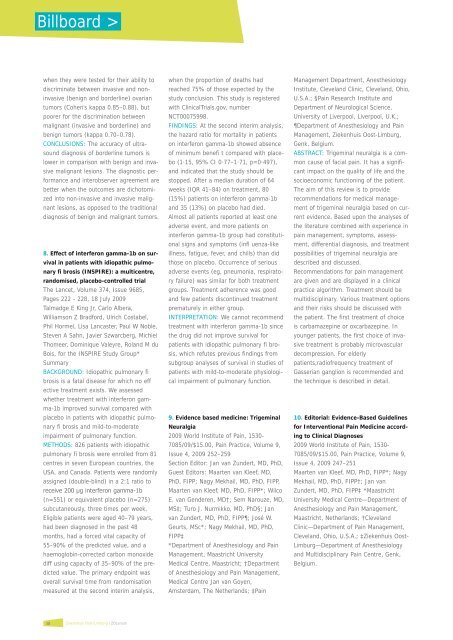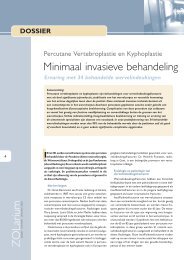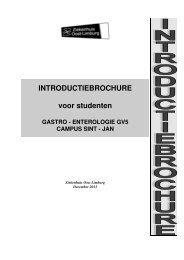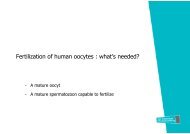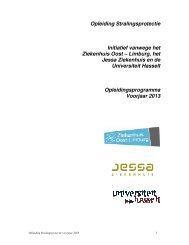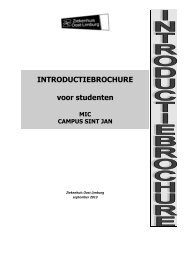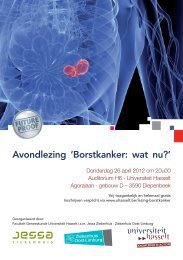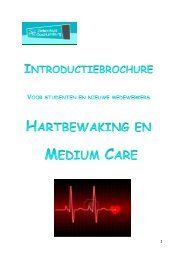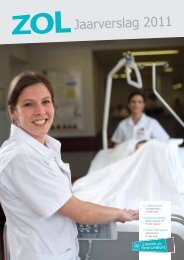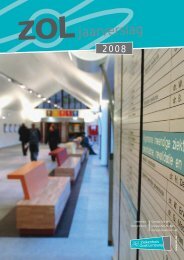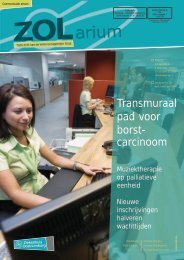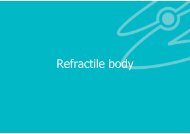Gerizol over ouderen op spoed Gerizol over ouderen op spoed
Gerizol over ouderen op spoed Gerizol over ouderen op spoed
Gerizol over ouderen op spoed Gerizol over ouderen op spoed
You also want an ePaper? Increase the reach of your titles
YUMPU automatically turns print PDFs into web optimized ePapers that Google loves.
Billboard ><br />
when they were tested for their ability to<br />
discriminate between invasive and noninvasive<br />
(benign and borderline) ovarian<br />
tumors (Cohen’s kappa 0.85–0.88), but<br />
poorer for the discrimination between<br />
malignant (invasive and borderline) and<br />
benign tumors (kappa 0.70–0.78).<br />
Conclusions: The accuracy of ultrasound<br />
diagnosis of borderline tumors is<br />
lower in comparison with benign and invasive<br />
malignant lesions. The diagnostic performance<br />
and interobserver agreement are<br />
better when the outcomes are dichotomized<br />
into non-invasive and invasive malignant<br />
lesions, as <strong>op</strong>posed to the traditional<br />
diagnosis of benign and malignant tumors.<br />
8. Effect of interferon gamma-1b on survival<br />
in patients with idi<strong>op</strong>athic pulmonary<br />
fi brosis (INSPIRE): a multicentre,<br />
randomised, placebo-controlled trial<br />
The Lancet, Volume 374, Issue 9685,<br />
Pages 222 - 228, 18 July 2009<br />
Talmadge E King Jr, Carlo Albera,<br />
Williamson Z Bradford, Ulrich Costabel,<br />
Phil Hormel, Lisa Lancaster, Paul W Noble,<br />
Steven A Sahn, Javier Szwarcberg, Michiel<br />
Thomeer, Dominique Valeyre, Roland M du<br />
Bois, for the INSPIRE Study Group*<br />
Summary<br />
Background: Idi<strong>op</strong>athic pulmonary fi<br />
brosis is a fatal disease for which no eff<br />
ective treatment exists. We assessed<br />
whether treatment with interferon gamma-1b<br />
improved survival compared with<br />
placebo in patients with idi<strong>op</strong>athic pulmonary<br />
fi brosis and mild-to-moderate<br />
impairment of pulmonary function.<br />
Methods: 826 patients with idi<strong>op</strong>athic<br />
pulmonary fi brosis were enrolled from 81<br />
centres in seven Eur<strong>op</strong>ean countries, the<br />
USA, and Canada. Patients were randomly<br />
assigned (double-blind) in a 2:1 ratio to<br />
receive 200 μg interferon gamma-1b<br />
(n=551) or equivalent placebo (n=275)<br />
subcutaneously, three times per week.<br />
Eligible patients were aged 40–79 years,<br />
had been diagnosed in the past 48<br />
months, had a forced vital capacity of<br />
55–90% of the predicted value, and a<br />
haemoglobin-corrected carbon monoxide<br />
diff using capacity of 35–90% of the predicted<br />
value. The primary endpoint was<br />
<strong>over</strong>all survival time from randomisation<br />
measured at the second interim analysis,<br />
when the pr<strong>op</strong>ortion of deaths had<br />
reached 75% of those expected by the<br />
study conclusion. This study is registered<br />
with ClinicalTrials.gov, number<br />
NCT00075998.<br />
Findings: At the second interim analysis,<br />
the hazard ratio for mortality in patients<br />
on interferon gamma-1b showed absence<br />
of minimum benefi t compared with placebo<br />
(1·15, 95% CI 0·77–1·71, p=0·497),<br />
and indicated that the study should be<br />
st<strong>op</strong>ped. After a median duration of 64<br />
weeks (IQR 41–84) on treatment, 80<br />
(15%) patients on interferon gamma-1b<br />
and 35 (13%) on placebo had died.<br />
Almost all patients reported at least one<br />
adverse event, and more patients on<br />
interferon gamma-1b group had constitutional<br />
signs and symptoms (infl uenza-like<br />
illness, fatigue, fever, and chills) than did<br />
those on placebo. Occurrence of serious<br />
adverse events (eg, pneumonia, respiratory<br />
failure) was similar for both treatment<br />
groups. Treatment adherence was good<br />
and few patients discontinued treatment<br />
prematurely in either group.<br />
Interpretation: We cannot recommend<br />
treatment with interferon gamma-1b since<br />
the drug did not improve survival for<br />
patients with idi<strong>op</strong>athic pulmonary fi brosis,<br />
which refutes previous findings from<br />
subgroup analyses of survival in studies of<br />
patients with mild-to-moderate physiological<br />
impairment of pulmonary function.<br />
9. Evidence based medicine: Trigeminal<br />
Neuralgia<br />
2009 World Institute of Pain, 1530-<br />
7085/09/$15.00, Pain Practice, Volume 9,<br />
Issue 4, 2009 252–259<br />
Section Editor: Jan van Zundert, MD, PhD,<br />
Guest Editors: Maarten van Kleef, MD,<br />
PhD, FIPP; Nagy Mekhail, MD, PhD, FIPP,<br />
Maarten van Kleef, MD, PhD, FIPP*; Wilco<br />
E. van Genderen, MD†; Sem Narouze, MD,<br />
MS‡; Turo J. Nurmikko, MD, PhD§; Jan<br />
van Zundert, MD, PhD, FIPP; José W.<br />
Geurts, MSc*; Nagy Mekhail, MD, PhD,<br />
FIPP‡<br />
*Department of Anesthesiology and Pain<br />
Management, Maastricht University<br />
Medical Centre, Maastricht; †Department<br />
of Anesthesiology and Pain Management,<br />
Medical Centre Jan van Goyen,<br />
Amsterdam, The Netherlands; ‡Pain<br />
Management Department, Anesthesiology<br />
Institute, Cleveland Clinic, Cleveland, Ohio,<br />
U.S.A.; §Pain Research Institute and<br />
Department of Neurological Science,<br />
University of Liverpool, Liverpool, U.K.;<br />
Department of Anesthesiology and Pain<br />
Management, Ziekenhuis Oost-Limburg,<br />
Genk, Belgium.<br />
Abstract: Trigeminal neuralgia is a common<br />
cause of facial pain. It has a significant<br />
impact on the quality of life and the<br />
socioeconomic functioning of the patient.<br />
The aim of this review is to provide<br />
recommendations for medical management<br />
of trigeminal neuralgia based on current<br />
evidence. Based upon the analyses of<br />
the literature combined with experience in<br />
pain management, symptoms, assessment,<br />
differential diagnosis, and treatment<br />
possibilities of trigeminal neuralgia are<br />
described and discussed.<br />
Recommendations for pain management<br />
are given and are displayed in a clinical<br />
practice algorithm. Treatment should be<br />
multidisciplinary. Various treatment <strong>op</strong>tions<br />
and their risks should be discussed with<br />
the patient. The first treatment of choice<br />
is carbamazepine or oxcarbazepine. In<br />
younger patients, the first choice of invasive<br />
treatment is probably microvascular<br />
decompression. For elderly<br />
patients,radiofrequency treatment of<br />
Gasserian ganglion is recommended and<br />
the technique is described in detail.<br />
10. Editorial: Evidence-Based Guidelines<br />
for Interventional Pain Medicine according<br />
to Clinical Diagnoses<br />
2009 World Institute of Pain, 1530-<br />
7085/09/$15.00, Pain Practice, Volume 9,<br />
Issue 4, 2009 247–251<br />
Maarten van Kleef, MD, PhD, FIPP*; Nagy<br />
Mekhail, MD, PhD, FIPP†; Jan van<br />
Zundert, MD, PhD, FIPP‡ *Maastricht<br />
University Medical Centre—Department of<br />
Anesthesiology and Pain Management,<br />
Maastricht, Netherlands; †Cleveland<br />
Clinic—Department of Pain Management,<br />
Cleveland, Ohio, U.S.A.; ‡Ziekenhuis Oost-<br />
Limburg—Department of Anesthesiology<br />
and Multidisciplinary Pain Centre, Genk,<br />
Belgium.<br />
38 Ziekenhuis Oost-Limburg I ZOLarium


